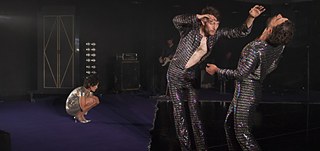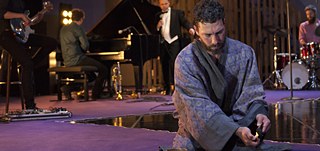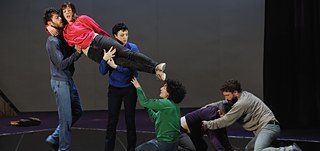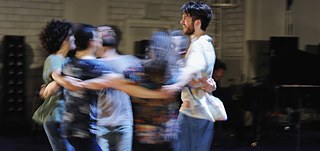Meg Stuart/Damaged Goods at Montreal's Festival Transamériques
Until Our Hearts Stop
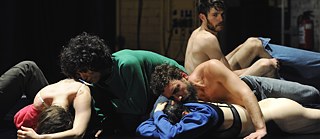
In Until Our Hearts Stop, Meg Stuart and her Brussels-Berlin based company, Damaged Goods, offer a comic and sometimes caustic take on the banalities and intimacies of life.
As the audience enters the theatre, the performers are hanging out upstage in what resembles both a music studio and a living room of sorts, with music instruments on one side of the space, a purple drape suspended from the ceiling, a diamond-shaped floor space, surrounded by expanses of purple floor covering, and on the other side, a couch and a stack of paintings.
An ultimate state of calm pervades the space. Gently the physical connections build – a dancer crouches on another’s pelvis, climbs onto the back of another, or stands on someone’s thighs, while someone else grabs another performer’s hair to gain balance. The performers negotiate the possibilities of physicality, and bit by bit, touch and embrace, and in a few more familiar moments, smell and taste (hair is particularly fetishized) are explored. In these opening minutes, Stuart seems to be referencing Simone Forti’s iconic “Huddle,” as performers build their ground, interlocking their bodies in a huddle of sorts. In the evolving piling of bodies, the performers disentangle and then gain new solid ground, coming together in one happy sandwich of humanity.
The possibilities of play
Until Our Hearts Stop was created collaboratively with the engaging, resourceful performers Neil Callaghan, Jared Gradinger, Leyla Postalcioglu, Maria F. Scaroni, Claire Vivianne Sobottke, Kristof Van Boven, with original live music provided by the excellent Samuel Halscheidt, Marc Lohr, and Stefan Rusconi. The cast operates within a series of clustered ideas rooted in improvisation and centred on disturbance, changing circumstance, entanglement, and support. They move in tandem, breaking away, coming together, reacting, forming and reforming their actions. For audiences, watching all this activity, as always, has ebbs and flows of satisfaction. When the shifting movements and formations are less gratifying or lack punch, there’s always the music to revel in. More importantly, the music elevates the texture and tone of the sequences.The body, as presented in the work, is a container for memory, healing, pushing limits, and the progression of the piece explores the possibilities of play. Stuart builds on the shared trust of her performers, seemingly challenging their limits and ours. The apex of the evening is Sobottke and Scaroni’s urgent, playful, naked wrestling match – grabbing breasts and pulling pubic hair, the manipulation is never particularly sexual or abusive, but is charged with a lovable, flirting, silly kind of feuding. Yes, they nuzzle and probe the other’s crotch, but there is something very childlike in even their most physically confrontational convergence. Meanwhile, Callaghan, Gradinger, and Lohr engage in a writhing, bare-bodied smacking session, that drives the exploration of the boundaries of pain and pleasure.
Labeled as ‘edgy’
After an hour or so into the performance, it’s time for audience participation. There’s a good-natured confrontational tone as the performers shake people beyond their complacent spectator role. Food and drink are offered (scotch and cake, yes, please!), and tall tales are shared about various audience members. Easy laughs and groans ensue. None of this is particularly new, despite the disarming cast. In fact, this was the breaking point in terms of the focus of the piece, with the percussive and rhythmic energy of the first half dissipating. Clocking in at just under two-and-a half hours, the work is glutted. Despite flourishes, and the charm and hard-working performers’ best efforts, the rest of what’s presented is rendered thin and simplistic. By the time Sobottke, in a final sequence, tries to entice the audience to share an intimate evening with her in her hotel room, and then in another attempt makes a plea to take the entire cast on a full-tilt drinking and drug spree, there were absolutely no takers. Not to say that folks weren’t necessarily interested, but the audience was spent.“Turgid,” said one woman exiting the theatre. I overheard another say that he preferred Stuart’s earlier work, when she was angry. Meanwhile, a visiting programmer snapped that the choreographer is expert at mugging to the tastes of festivals unabashedly eager to drum up business with a public easily impressed with work labeled as ‘edgy’. Expressing desires and the complexities of our relationships in this canvas of intimacy is a brilliant concept; the show, in which too much is never enough, just overstays its welcome.
